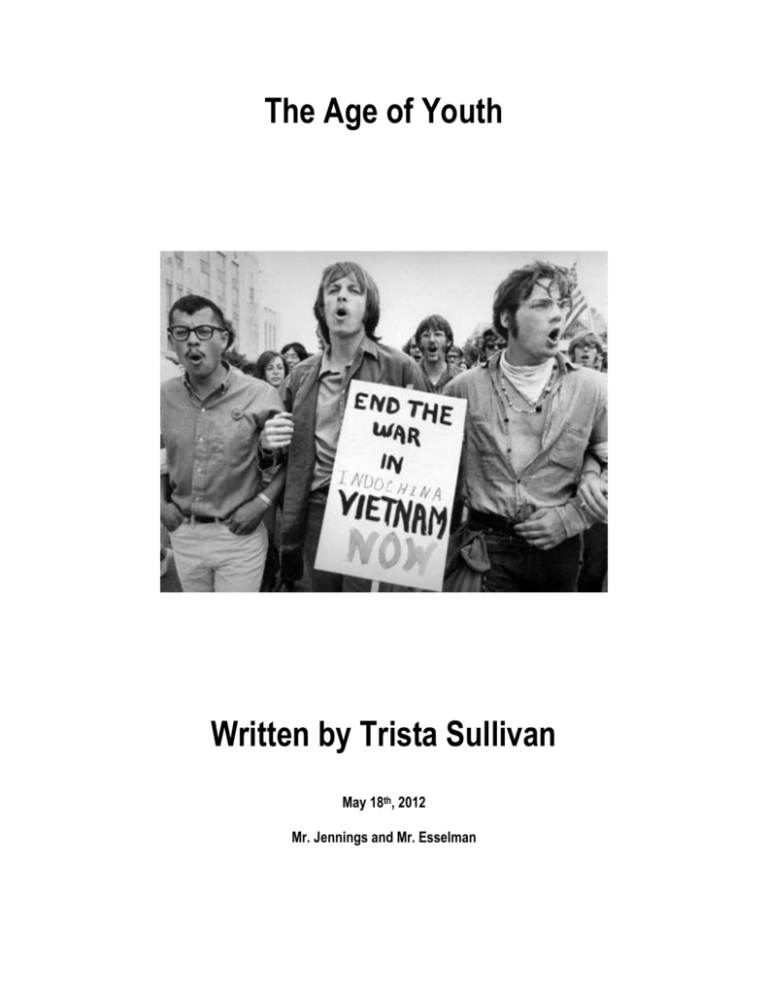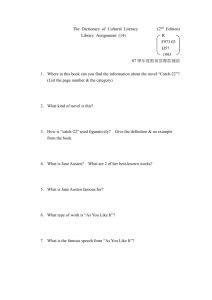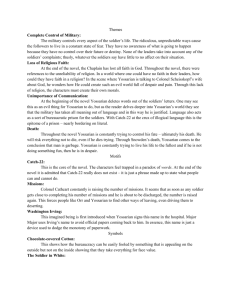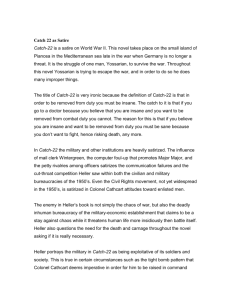Long zoom into medium - AHS LIBRARY OF BABEL
advertisement

The Age of Youth Written by Trista Sullivan May 18th, 2012 Mr. Jennings and Mr. Esselman The Age of Youth America is a country that is constantly undergoing many different forms of change and innovation over time. America is a country built on the freedom to make your own decisions. This inevitably led to a very diverse body, and from this body, many great works of art and technology were created. These works all have a great influence on the American society, and at times can even cause major changes, even to the point of complete revolution. These great works are also created as a reflection of what is happening in society at the time the work is created. Catch-22 is a novel written by Joseph Heller that showed the controversy and hypocrisy that war held so closely. This reflected the Vietnam War, and how messed up the war itself and consequently, the individuals would end up being. Though, in the novel the Squadron that the characters are in are fighting in World War II. This is not an exact reflection of what was going on when it was published in 1961, but its general purpose was to express the insanity in all wars. Along with the great works created, great individuals and voices become prominent over time. Prior to the 1960’s, the voice of the youth was not one to be taken seriously. Due to the antiwar movement in the 1960’s the youth of Americans grasped their voice, and amplified it for all of the citizens of America to hear: the young and the old. Joseph Heller’s Catch-22, published in 1961, is a character heavy story that holds many different themes. The story expresses motifs of insanity, heroism, brutality, and pure irony in a sense that people more often tend to want what they can’t have. This is expressed through “Catch-22” which is now a coined term. A Catch-22 is in the simplest sense, a paradoxical situation that one can find himself in. The Catch-22 is explained in multiple scenarios throughout the novel: the first scenario being a situation in which soldiers can ask for grounding. If a soldier is mentally insane, and asks a doctor to be grounded, the doctor can ground him. Any sane man would quickly ask for grounding while a man who was truly insane would not even think to do that; he would continue flying his missions, not fearing death in the slightest. Joseph Heller prominently uses characterization to express the themes of the novel. War is an insane institution that produces soldiers just as insane as the war. The novel begins with John Yossarian, a bombardier. Yossarian showed himself to be an anti-hero. Though, in the beginning of the novel we are lead to believe that Yossarian is the only sane man. He ends up being just as insane as the men he chastises: this makes him the anti-hero of the story. “After he made up his mind to spend the rest of the war in the hospital, Yossarian wrote letters to everyone he knew saying that he was in the hospital but never mentioning why. One day he had a better idea. To everyone he knew he wrote that he was going on a very dangerous mission. ‘They asked for volunteers. It's very dangerous, but someone has to do it. I'll write you the instant I get back.’ And he had not written anyone since” (Heller 8). Yossarian does not believe that he is insane; more so that everyone around him is insane and he is the only sane one out of them all. Heller shows different types of insanity in different characters. “Hungry Joe did have fifty missions, but they were no help. He had his bags packed and was waiting again to go home. At night he had eerie, ear-splitting nightmares that kept everyone in the squadron awake but Huple, the fifteen-yearold pilot who had lied about his age to get into the Army and lived with his pet cat in the same tent with Hungry Joe. Huple was a light sleeper, but claimed he never heard Hungry Joe scream. Hungry Joe was sick” (Heller 51). The use of each individual chapter in the novel being written for an individual character helped organize the characterization and the contrast between characters and their interactions well. "Why,’ sword Yossarian at him approvingly, ‘you evil-eyed, mechanically-aptituded, disaffiliated son of a bitch, did you walk around with anything in your cheeks" (Heller 23). Orr manipulated Yossarian into a circle of questions and never got to the point in answering Yossarian’s question. Heller used interactions like these between characters to accurately contrast the differences in the insanity characters. Looking Back At Catch-22 supported the thesis stated in a number of ways. The article emphasized the relationship and the insanity expressed through the characters Yossarian and Clevinger, Yossarians squadron mate. It is said that it was Yossarian’s reflections on the war itself that led him to his insanity. “Clevinger and Yossarian are certain that the other is crazy. In fact, so far as Yossarian is concerned, everyone is crazy who thinks that any sense can be made out of getting killed” (Podhoretz 4). Doc Daneeka’s insanity is almost as strong as Yossarian’s and similar as well. They both shared the same fear of death and the same attitude about the entire war. While this article explains a few of the insanities of characters, it also shows that Daneeka and Yossarian had a healthy, sane fear of death while the others did not. “Boys on every side of the bomb line were laying down their lives for what they had been told was their country, and no one seemed to mind lest of all the boys who were laying down their young lives” (Podhoretz 4). This could go either way in regards to supporting the first thesis stated. It could show the true insanity between the characters or it could show the sanity of Yossarian and Daneeka by showing sane reactions and emotions toward the war – fear and remorse – while the characters that were insane were the ones eager to fly missions and receive praise from the officers for killing and destroying enemies. This leads into a second thematic statement that Heller expresses through the situations that the characters find themselves in. In any situation that one finds them selves in, there will always be a catch. For officers to receive high, honorable rankings in the novel, they had to do things that they would eventually resent them self for, such as killing hundreds of people, or emotionally torturing the men that are assigned under them. The catch that comes along with the honor of being a high officer was that the process turned the men insane as well as the high officer. Along with this Catch, there is also the catch along with being grounded that was cited previously. The second source focused on a main idea of the satire that Joseph Heller used throughout his novel. The article goes into great deal about the coined term that Heller had consequently created when writing Catch-22: a catch. This term is often used today in the same aspect as in the novel. “This brand new car can be yours by just completing this user survey!” says a car dealer. “What’s the catch?” replies the victim. In the novel’s case, the catch pertained to the military procedures and the irony that the situations held. “Sergeant Whitcomb, for example, feels delighted that twelve more men have been killed in combat (and they are sent duplicated ‘personalized’ letters of condolence) because his chances are increased of getting and article in Saturday Evening Post in praise of his commanding officer” (Walsh 3). A prime example of the catch; in order for Sergeant Whitcomb to achieve something that he greatly aspired for, being in the post, he had to benefit from the loss of twelve of his men. The most ironic catch is the entire war that the squadron was fighting. This applies to the war that Heller had described, and any war that is experienced outside of the novel. The main goal of any war is to achieve a great victory, but at what cost? The cost of cities, earth, foreign casualties and deaths, and even the casualties and deaths of ones own soldiers and citizens. The situations that the characters were involved in and the characterization in Heller’s Catch-22 not only revealed the insanity within the characters, but also the true irony and satire of the war that the characters were fighting. In conclusion, Heller’s use of characterization and character interactions prominently shows multiple common themes in the novel. In any situation that one finds them selves in, there will always be a catch. This theme was expressed through the dialogue and plot of the novel. Secondly, war is an insane institution that produces soldiers just as insane as the war. This is expressed through the individual characterization and the personal thoughts and opinions that characters have on themselves and their peers; often using their own self as a standard of sanity. To achieve greatness during this war, there would be a catch. Insanity. The first thing one thinks about when they think of the 1960’s is most likely rainbows, flowers, tie-dye, hippies, and peace signs. What people most often look over were the extreme social, political, and artistic advancements and innovations that flourished during the 1960’s. Those 10 years were a time for change, a time for revolution, a time for peace, a time for art, and a time for love. With the civil rights movements for the equality of African Americans on the rise, the presidency and assassination of John F. Kennedy, the presidency of Lyndon B. Johnshon, the American involvement in the Vietnam War, and its protestors all shaped these themes during this age of youth. Change. Hope. Security. These words are frequently heard and contemplated by millions of Americans across the nation. Idealistically, these words describe exactly what we want in our government and country. One could say that these are major themes of the 21st century, and the same could easily be said for the 1960’s or any other time for that matter. America is a country that is constantly under renovation and growth. But, these words are incredibly vast, almost to the point where the meaning behind these ideas are lost. For the themes of the 1960’s one must dissect the events that occurred to thoroughly understand the aspirations and ideals that this decade held on to. A time for change. The civil rights movement and the fight for the equality of African American people were inevitably on the path for success. “Kennedy emphasized the need for executive action rather than legislation in the area of civil rights, and for more than two years after his election, Kennedy pursued that course” (Lord 151). In 1961, President John F. Kennedy was elected. The beginning of the decade showed positive signs for Civil Rights with Kennedy’s emphasis on the actions taken toward the Civil Rights movement. The amount of Civil Rights lawyers had increased at the beginning of Kennedy’s Presidency, making the vision of equal voting rights and employment rights a battle with stronger forces. Along with the growth in Civil Rights lawyers, the Kennedy Administration passed the Civil Rights Act of 1964, which furthered the success in desegregation of students in public schools. “Armed with these two laws, as limited as they were, the Justice Department under Attorney General Robert Kennedy and Burke Marshall, head of the Civil Rights Division, accomplished more for civil rights in three years than all other previous administrations combined” (Lord 151152). Along with the Kennedy Administration working hard for the equality of African Americans, Martin Luther King Jr. and the people of the country were fighting for these rights as well. King led the masses in protest through a nonviolent confrontation similar civil disobedience that was practiced by Mahatma Ghandi. King was seen as a symbol of hopes, dreams, equality, and justice, and still is in our modern day. Not only did he represent the African Americans in their fight for equality, he was looked up to by woman fighting for civil equality as well. “He spoke of a universal morality, appealed to a general sense of human justice, and envisioned a ‘beloved community’ that knew no barriers between people. King’s movement was not about particular rights; its goal was the moral redemption of the United States” (Steigerwald 43). A time for revolution. A time for peace. “Teach me occasionally Over and over How to love And not how to die To remember and How to remember How to ask why and To ask why Teach me over The noise of bombers That blacken out The clear blue sky” (Robbins xvii) This was a poem written by an activist written by Howard Zinn. He was apart of the youth and antiwar movement during the 1960’s. The actions taken toward the Vietnam War led to a youth ran revolution demanding peace. Many individuals saw the Vietnam War to be ridiculous and pointless: even a way of the United States throwing around its power and technology. “From 1964 to 1972, the wealthiest and most powerful nation in the history of the world made a maximum military effort, with everything short of atomic bombs, to defeat a nationalist revolutionary movement in a tiny peasant country – and failed” (Zinn 4). As a result of this, the American youth had started the loudest and most powerful antiwar movement that America had even seen. Student protests were not an uncommon occurrence during this time. Some of these protests lead to the end of many government and military programs that these young people were fighting against. For example the Reserve Officers Training Corps, a college training program to turn graduates into commissioned officers in the Vietnam War, was canceled in over forty institutions due to large student protests. “The publicity given to the student protests created the impression that the oppositions to the war came mostly from middle-class intellectuals” (Against the Vietnam War 27). The voice of the people, young, old, rich, and poor, was being heard and actions were being taken based on this word and protest. This large antiwar movement could easily be said to have ended the Vietnam War. A time for art. A time for love. A time for peace. The antiwar movement and artistic world of the 1960’s unified the youth across the nation. “Woodstock became more than three days of music and counterculture lifestyle. It seemed to symbolize the possibility of a community built on love, rock ‘n’ roll, drugs, and a communal approach to the life itself” (Takin’ it to the streets 607-608) Woodstock is a prime example of this unification of the youth through art and peace. 300,000+ people from all across the nation traveled hundreds to thousands of miles to attend this three day long festival. Artists that performed there spoke out to their fellow people. They spoke of music, love, and most importantly peace. “I went rather casually,’ he wrote, ‘partly because I wanted to hear the music, and partly because I knew, by word of mouth, that there would be a tremendous mass of people my age, and I wanted to be part of it” (Takin’ it to the streets 608). Woodstock was a time that people wanted to live in forever. The individuals that attended Woodstock felt as if they were in their own division from the world. As mass storms were reported on the radio, festival go-ers laughed and had no fear toward these storms. They embraced the weather and what it held for them as they had embraced each other. Woodstock truly established a separate world on earth in which all of these people all felt the same sense of community. This sense of community was not one that they had felt out side of the festival, but had hoped to have in the future. The 1960’s in a nutshell is the age of the youth. The antiwar movement, civil rights movement, and artistic movements all seemed to be carried and kept alive by the youth of America. First, the civil rights movement and the fight for the equality of African American people were inevitably on the path for success. Second, the actions taken toward the Vietnam War led to a youth-led revolution demanding peace. Third, the antiwar movement and artistic world of the 1960’s unified the youth across the nation. The 1960’s was the time for the youth to show the public what they were made of and the large effect that they could have on the country. Before this time, the youth were kept quiet and out of sight as the adults handled the nation. This innovation for the youth would not be short lived, for today, youth are constantly speaking out and making dramatic changes in the country. Our founding fathers worked vigorously to create a government based on freedom and democracy to ensure a bright future for all who live in it. The rights of all of the American citizens are granted and protected by the government. For this, not only do we thank the founding fathers and all who made the American government possible, such as the soldiers who fought for independence against Britain and the soldiers who fight for our protection today. But Americans have the United States Constitution to thank for holding itself up, along with an entire nation. The American Government is one of the only governments that grant such power and freedom to the individuals that live under it. America is the home of the free, and governed by such. The focal point of this synthesis is the 1st Amendment of the United States Constitution. “Congress shall make no law respecting an establishment of religion, or prohibiting the free exercise thereof; or abridging the freedom of speech, or of the press; or the right of the people peaceably to assemble, and to petition the Government for a redress of grievances” (Bill of Rights Transcript Text). As American citizens, we practice these 5 rights given to us in the 1st Amendment on a daily basis. Some countries however, do not grant their citizens these rights. Speaking out against the government is a federal offense and is punished as such in many other countries. Americans are notorious for taking what they have in their lives for granted. Be it their cars, their family, theirs jobs, the food on their plates, or the roof above their head. The 5 rights given to Americans are often taken for granted as well. During the 1960’s, the youth were on the rise, their voices were being heard, and they were screaming “Revolution.” They did not like what they saw in the country’s citizens or in the government. Progressing though the antiwar movement, the youth walked along side. It was their time for their actions and words to be acknowledged and their aspiration was of revolution and in America, this could be attainable. Though, it is attainable through the amount of people revolting, the ideas behind the revolution, and even money to help support this revolution, the main attribution to the revolution isn’t even recognized by those revolting. The American Government was founded on the people and protecting the people and this meant protecting their right to protest. The very government that the youth were revolting against was the exact institution allowing and protecting their revolution, under the Constitution. What a catch. With all of the irony and the use of a catch that Heller applied to every military situation in the novel, it brought the characters to a point of hopelessness. Heller was saying this about war it self, that war and all the actions within it are hopeless. Heller’s Catch-22 represents the situations of irony such as an American revolution. Though the Catch-22 that pertains to such revolution may be a motive of Heller’s publication of this novel, the allegory on war and the extremities and insanity that comes along with it was Heller’s reason for writing this novel. Throughout the book, Heller uses utterly insane situations and just as insane characters to express his opinion on war. Joseph Heller, a bombardier himself, obtained a first hand account on war, giving him much material to work with for his novel. He aspired to show the public the insanity and hopelessness that was warfare in and out of the battle. All of Heller’s characters were insane, though all thinking that they were the only sane man in the squadron. Heller was insistent on the complete insanity, if not already present in the man before the war, then the insanity that was induced by such a horrific state that was in fact war. A novel such as this would only aid the antiwar movement against the Vietnam War, for the soldiers upon their return were mentally and physically destroyed. The sanity of many soldiers left them as they left American, their families, and their homes to go fight an unjust war. Just like Heller’s characters, the situations that these soldiers were facing were utterly horrific and insane. The allegory that Heller wrote was not only a mockery of the institution of war, but a wake up call to some readers that never looked beyond the problems on the shores of America. The 1960’s was the century for youth and revolution, for never before had the youth of America have such a loud voice and large impact upon the way of life in America. Previously, the youth were shut out and not taken seriously. The youth revolution of the 1960’s would change the lives of all the youth for years to come. Modern day youth are following in the foot steps of the 1960’s youth, for many youth organizations are flourishing across the country and these organizations are in the process of making a difference, and some day will, just as the youth of the 1960’s did. After the 1960’s the country would never under estimate the minds and power of the youth again and never again would the youth under estimate themselves. Change is inevitable, but those who cause the change, at times can be a dark figure lost in the fog; when least expected the future emerges from the fog. Annotated Bibliography Bill of Rights Transcript Text." Bill of Rights Transcript Text. Web. 16 May 2012. <http://www.archives.gov/exhibits/charters/bill_of_rights_transcript.html>. The first amendment gives the freedom of speech, religion, petition, assembly, and press. This source was only used to quote the first amendment. Bloom, Alexander, and Wini Breines. "Takin' It to the Streets": A Sixties Reader. New York: Oxford UP, 1995. Print. A large overview of the 1960's. Topics ranged from Civil Rights, Women's Rights, the Anti-war Movement, and the Cuban Missile Crisis. It is a very credible secondary source which also had primary sources within the secondary sources. Heller, Joseph. Catch-22, a Novel. New York: Simon and Schuster, 1961. Print. Catch-22 is a satirical novel on war. The story takes place on an island near Italy during World War II. Joseph Heller takes us through different scenarios and missions with a diverse group of characters. Insanity and hypocrisy are both prominent themes in this novel. Li, Xiaobing. Voices from the Vietnam War: Stories from American, Asian, and Russian Veterans. Lexington, KY: University of Kentucky, 2010. Print. Stories and accounts from not only American but Vietnamese soldiers during the Vietnam War. This source has an abundance of primary sources. Some showing the terror and psychological effect of the Vietnam War. Logevall, Fredrick. "Lyndon Johnson and Vietnam." JSTOR. Web. 30 Mar. 2012. <http://www.jstor.org/stable/27552566>. This article is a secondary source on the topic of Lyndon B Johnson and his actions taken toward the Vietnam War and the rise of Communism. Hanoi Leadership and U.S. Intervention is a major concept in this article. Lord, Donald C. "JFK and Civil Rights." JSTOR. Web. 30 Mar. 2012. <http://www.jstor.org/stable/27547391>. A secondary source on the presidency of John F Kennedy and the actions he took toward civil rights. The Kennedy Administration was very progressive when it came to the civil rights movement. Marfleet, B. G. "The Operational Code of John F. Kennedy during the Cuban Missile Crisis: A Comparison of Public and Private Rhetoric." JSTOR. Web. 30 Mar. 2012. <http://www.jstor.org/stable/3791850>. This article discussed the Cold War during the 1960's and the Cuban Missile Crisis under the Kennedy Administration. It also discussed a variety of communist powers during this time period. Podhoretz, Norman. "Looking Back At 'Catch-22'" EBSCO. Web. 18 Apr. 2012. This article expresses the merits of Joseph Heller's Catch-22 and gave a general analysis and overview of the novel. The analysis pointed out some of the situations and characters and how they supported certain themes of the novel such as insanity. Steigerwald, David. The Sixties and the End of Modern America. New York: St. Martin's, 1995. Print. This source is a secondary source giving a large overview of the 1960's. It had a lot of credible information about the Vietnam War, the Civil Rights Movement, and the Administrations of the Presidents during the 1960's. Walsh, Jeffrey. "Towards Vietnam: Portraying Modern War." Gale, 2003. Web. 30 Mar. 2012. This source explains and expresses the concept of a 'catch' in the novel. It shows a number of situations in which the catch is show in the novel. It also discusses the coined term "Catch-22" that came about after the publication of this novel. Whittaker, James O. "Psychological Warfare in Vietnam." JSTOR. Web. 30 Mar. 20112. <http://www.jstor.org/stable/3791991 .>. This source shared information on Viet Cong, the Chieu Hoi Program, and other warfare states during Vietnam. The source has a secondary source commentary and a few primary sources such as writings from soldiers and pictures, drawn and taken by individuals during the war. Zinn, Howard and Robbins, Mary Susannah. Against the Vietnam War: Writings by Activists. Syracuse, NY: Syracuse UP, 1999. Print. Different stories and opinions are expressed through a variety of authors who were a part of the anti-war movement in the 1960's. This source is very credible because all of the individual chapters are primary documents from individuals experiencing America during the Vietnam War.





